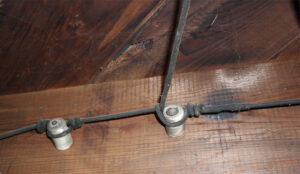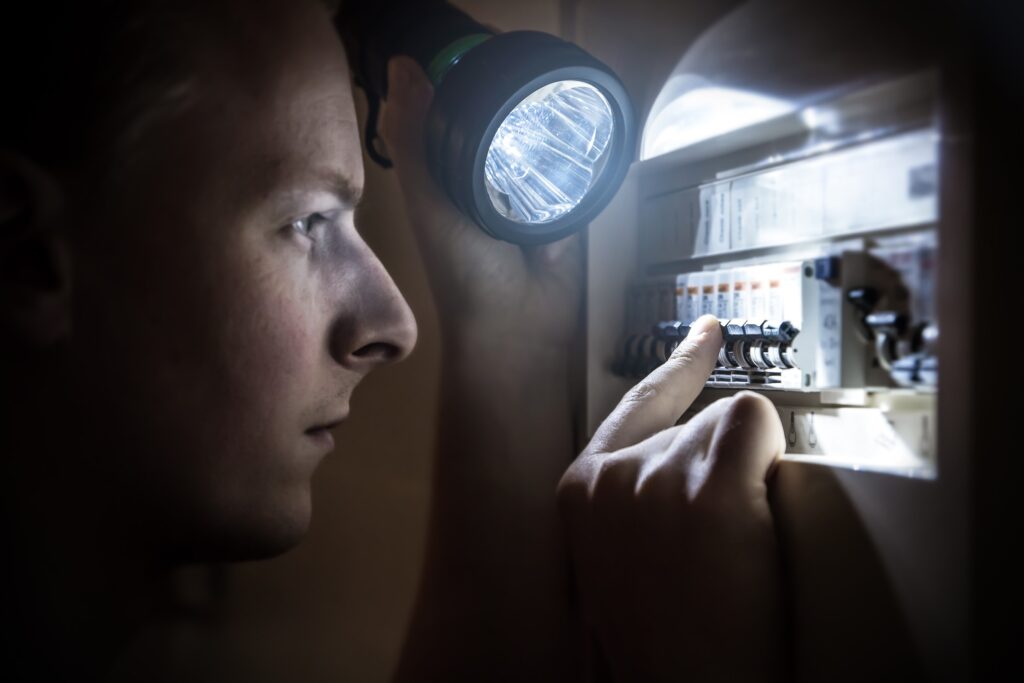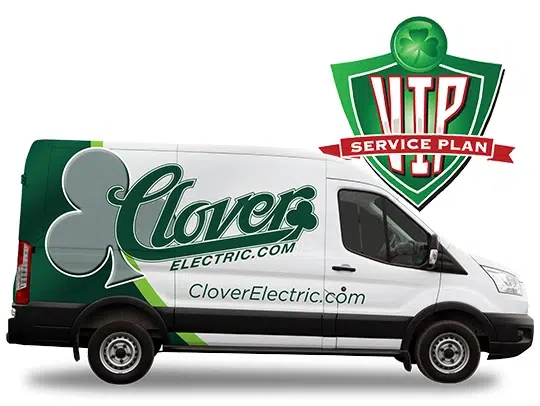Knob-and-tube wiring was one of the earliest standardized types of electrical systems and was commonly used in American homes and businesses from the 1880s to the 1940s and 1950s. It was then quickly phased out once safer, better alternatives were developed. Nowadays, it’s considered extremely outdated, despite still being found in thousands of older buildings. While some knob-and-tube systems remain safe and function without issues, there are still numerous reasons why rewiring a house with this type of wiring is a prudent decision.

What Is Knob-and-Tube Wiring?
Knob-and-tube systems consist of individual copper wires that supply power to outlets and light fixtures and are securely attached and supported in various places by wrapping the wire around cylindrical ceramic knobs mounted on wall studs, floor joists, trusses or rafters. The wires pass through holes that are drilled into the wood and are isolated from the wood by porcelain tubes inserted into the holes. The copper wires are also insulated with an asphalt-covered cloth or rubber.
Potential Issues With Knob-and-Tube Wiring
Knob-and-tube wiring presents several concerns and potential safety hazards. One problem is that this type of system simply wasn’t designed to meet the increased electrical needs of modern life, and they often can’t conduct as much power as you may need. That means you typically won’t be able to install air conditioning, a hot tub or an EV charger without first upgrading your wiring and your electrical panel.
Knob-and-tube wiring also isn’t grounded, which means it has no way to disperse excess current in the event of a power surge or short circuit. That means there’s a far greater risk of your appliances and devices getting damaged.
In terms of potential safety hazards, the primary concern is that the insulation around the copper wires becomes brittle over time, often resulting in cracking or breaking, and leaving part of the wire exposed. This creates a potential for the hot wire to ignite nearby items.
Knob-and-tube systems also have fuses, which aren’t nearly as safe and reliable as circuit breakers. That’s because a fuse can sometimes fail to blow if the circuit is overloaded, potentially leading to the wiring overheating and starting a fire.
The risk of fire is why many insurance companies won’t insure homes with knob-and-tube wiring. Some will still do so, but they usually charge much higher premiums than for houses with modern electrical systems.
Is Rewiring Worth It?
Rewiring a house and replacing old knob-and-tube wiring is an extensive and costly process that involves cutting holes in walls and ceilings to remove the old wiring and then pulling the new wiring to all of the outlets, light fixtures, and appliances. When upgrading from knob-and-tube wiring, it’s also necessary to replace the old electrical panel and fuses with a modern circuit breaker panel.
Despite the high cost, whole-house rewiring is almost always worthwhile for several reasons. The primary benefit is that it will make your home safer and reduce the risk of electrical fires or property damage. Rewiring your house will also make it much easier to secure or renew homeowner’s insurance and help you find a policy with lower premiums.
Another significant benefit is that it will increase the value of your home and make it much easier to sell should you decide to do so. Many people looking to buy a new home won’t consider buying a house with knob-and-tube wiring due to the potential safety risks. Even those who may be willing to generally won’t offer nearly as much as they otherwise might have. This is because they know they’ll need to pay the high cost to replace all of the wiring and upgrade the electrical system.
Signs You Should Rewire Your Home
Even if your house doesn’t have knob-and-tube wiring, there are still many other situations where rewiring is worth it. Two situations where professional electricians always recommend rewiring are when the house has a fuse box instead of a circuit breaker panel or when it has aluminum wiring instead of copper. Aluminum wiring also creates an increased risk of fires. Copper is a better conductor of heat, but it also transfers heat more efficiently, allowing the wires to stay cooler. Aluminum wiring, on the other hand, radiates more heat into the surrounding area, increasing the likelihood of nearby building materials catching fire.
Many experts recommend fully rewiring a house every 30 years or so, but this really depends on the condition of the wiring and the electrical system in general. Frequent issues, such as overloads, tripped breakers and flickering lights, are often signs of deteriorated or damaged wiring. If you’re experiencing issues like these, it’s important to contact a licensed electrician for an electrical inspection to determine the cause and what it will take to resolve the problem and ensure your electrical system is safe.
Since 1985, Clover Electric has been the company homeowners throughout Northeast Ohio have trusted for all their electrical needs. We serve customers in Chagrin Falls and throughout the Cleveland and Akron areas and can help if you’re looking to rewire your house or need any other assistance with your electrical system. To schedule an inspection or any other service, contact us today.




